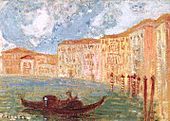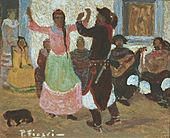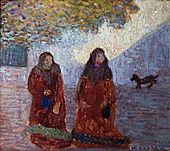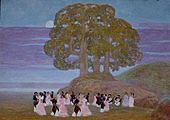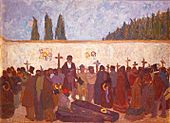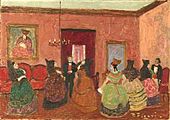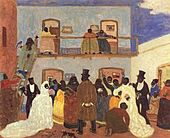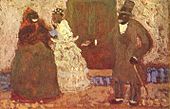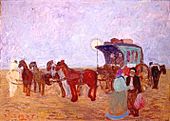Pedro Figari facts for kids
Quick facts for kids
Pedro Figari
|
|
|---|---|
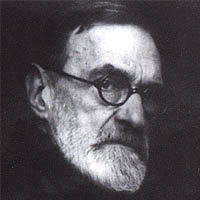 |
|
| Born |
Pedro Figari Solari
June 29, 1861 |
| Died | July 24, 1938 (aged 77) Montevideo
|
| Nationality | Uruguayan |
| Known for | lawyer, writer, politician, educator and artist |
| Movement | Impressionism |
Pedro Figari (born June 29, 1861 – died July 24, 1938) was a famous artist from Uruguay. He was also a lawyer, writer, and politician. Even though he started painting seriously later in his life, he is known as an early modernist painter. He loved to show everyday life in his art. In most of his paintings, he tried to capture the spirit of his home country. He painted local traditions and ways of life he remembered from his childhood.
Figari often painted from his memory. This made his artwork feel very personal. He had a special way of painting that didn't try to make things look perfectly real. Along with other important Latin American artists like Diego Rivera, he helped start a new artistic movement in Latin America. This movement focused on showing the unique identity of the region.
Contents
Life and training
Pedro Figari was born in 1861. When he was a child, he liked art. But for most of his life, he worked as a lawyer. In 1886, he finished his law degree. As a lawyer, he often helped poor people. This showed him many social problems that probably influenced his art later on. In the same year, Figari studied with Godofredo Sommavilla, an Italian painter. He also got married and traveled to France. In France, he saw Post-Impressionist art. This art style also had a big impact on his own work.
When Figari returned to Uruguay, he worked in journalism, law, and politics. He also helped create the School of Fine Arts. He was a member of the Uruguayan Parliament, which is like their government. He was also the head of the Ateneo of Montevideo and the director of the National School of Arts and Crafts.
Many people say Figari only started painting when he was older. But he had always painted a little bit. His early paintings were "tight watercolor and oil sketches." These early works had a classic charm and a cozy, everyday feel, like paintings by artists such as Édouard Manet and Edgar Degas.
It wasn't until 1921, when he was 60 years old, that Figari decided to paint full-time. He moved to Buenos Aires. There, he stopped using the Italian art style he had learned before. Instead, he started painting scenes from Uruguay. He painted the geography, the life of the gaucho (South American cowboys), celebrations, special rituals, and carnivals of the local Black community. He painted these scenes from his memory. When he went back to Paris in 1925, he kept painting these subjects. This helped him become well-known as a painter. His art was even part of the art competition at the 1932 Summer Olympics.
Style
Pedro Figari had a very unique style. Early in his career, Italian art influenced him a lot. But when he started painting seriously, he found a more simple and natural style.
Figari painted during a time when artists in South America were trying to find their own art style. They wanted their art to be different from European art. Before, many paintings showed impersonal scenes, like historical events. European paintings focused on perfect technique and realistic details. Figari was one of the first artists to move away from this European style. He wanted to create something new and original.
He believed that European ways of life had made life less simple and harmonious. He thought America offered a chance to go back to simpler times. This idea of "returning to origins" also showed in his paintings. Instead of painting things exactly as they looked, Figari wanted to capture the feeling of a moment. He once said, "My painting is not simply a way of painting. Rather, it is a way of seeing, thinking, feeling." He focused on showing energy and life, not just perfect copies of things. This is why his style is called "naïve." It allowed him to show the social habits of rich people in Uruguay in a simple, innocent way.
Relationship to artistic movements
When Pedro Figari traveled in Europe, he saw a lot of Post-Impressionist art. His own paintings showed early modernist qualities. They focused on the flat surface of the canvas. Modernist painting didn't try to create an illusion of reality. Instead of focusing on perfect form, modernist painters paid attention to the meaning of the art.
Figari's paintings also highlighted the materials he used. He didn't paint to make a subject look perfectly real. He painted to capture the ideas and feelings behind a piece. He did this by using special brush-strokes that fit the part of the painting he was working on. Sometimes, a part of his painting might not look perfectly drawn in a traditional way. But it was often much more expressive than the most accurate paintings by the Old Masters (famous painters from the past).
Legacy
Pedro Figari left behind a legacy of freedom and expression. He moved away from the common European art style that only allowed traditional ways of painting. By doing this, he helped people learn to celebrate their own country's culture. He said he wanted to "elevate Uruguayan culture and make people love the American things that are so very much their own."
By creating his own style that showed the spirit of Uruguay, he gave the people of his country a sense of pride. They no longer felt they had to copy European customs. Instead, they explored the history and roots of their own country.
In 1995, the Figari Award was created. It is named after Pedro Figari. This award is given every year to honor Uruguayan visual artists. Since 2010, the Museo Figari has managed the award. This museum in Montevideo is also named in his honor.
Gallery of paintings
List of exhibitions
- Drawings in Latin America, 1998, Museum of Modern Art (New York)
- Taller Pedro Figari, 1956, Salto
- Paintings by Pedro Figari, 1947, Museum of Fine Arts (Houston)
- Paintings and Prints by Artists of Various Nations, 1942, Museum of Fine Arts (Houston)
- Latin American Artists of the 20th Century, 1993, Museum of Modern Art (New York)
List of artworks
- Candombe Bajo La Luna, 1922 (Alfredo Gonzalez Garano Collection)
- Pericon En La Estancia, 1924 (Museo Nacional de Bellas Artes)
- En Familia, 1924 (Andres Garmendia Uranga Collection)
- Pericon, 1925 (Roque Freire Collection)
- Del Entierro, 1928 (Alejandro Shaw Collection)
- Candombe, 1924 (Roque Freire Collection)
- Patio Colonial, 1924 (Raul C. Monsegur Collection)
- El Cielito Bajo El Monte, 1923 (Celina Gonzalez Garano Collection)
- Entierro, 1921 (Museo Nacional de Bellas Artes)
- La Pampa, 1927 (Museo Nacional de Bellas Artes)
See also
 In Spanish: Pedro Figari para niños
In Spanish: Pedro Figari para niños


